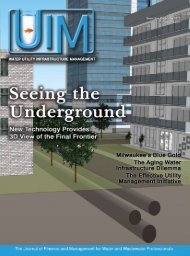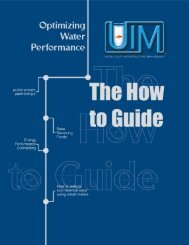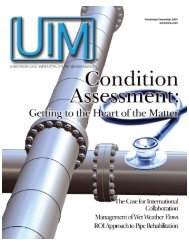Download - Water Utility Infrastructure Management
Download - Water Utility Infrastructure Management
Download - Water Utility Infrastructure Management
You also want an ePaper? Increase the reach of your titles
YUMPU automatically turns print PDFs into web optimized ePapers that Google loves.
ABC Predicts 2012 Will Be a<br />
Slow Year for Construction<br />
Associated Builders and Contractors (ABC) in November<br />
released its 2012 economic forecast for the U.S. commercial<br />
and industrial construction industry. “ABC’s analysis<br />
of construction trends indicates 2012 will be a year of<br />
gradual progress as advances in private construction are<br />
partially offset by ongoing declines in publicly financed<br />
construction,” said ABC Chief Economist Anirban Basu.<br />
“Nonresidential construction spending is expected to<br />
grow 2.4 percent in 2012 following a 2.4 percent decrease<br />
in 2011,” Basu said. “The pace of recovery in the nation’s<br />
nonresidential construction industry remains soft and<br />
2012 is positioned to be a year of slow gain. The first half<br />
of 2012 may be particularly challenging, a reflection of<br />
the soft patch in economic activity experienced during<br />
much of the first half of 2011.<br />
“ABC’s national Construction Backlog Indicator, which<br />
stood at 8.1 months for both the second and third quarters<br />
of 2011, is not expected to advance substantially and<br />
likely will remain in the vicinity of 8 months of backlog<br />
for much of 2012,” said Basu. “However, backlog is one<br />
month higher from the same time last year. A backlog of<br />
less than 8 months is associated with construction spending<br />
declines, while a backlog exceeding 8 months is statistically<br />
associated with future construction spending<br />
increases. Today’s level of backlog is consistent with flat<br />
construction spending.<br />
“Nonresidential building construction employment is<br />
expected to increase 0.4 percent in 2012 following lackluster<br />
0.6 percent growth in 2011,” Basu said. “Employers<br />
will continue to seek increased productivity among existing<br />
workers in order to boost weak industry margins.<br />
“There may be a degree of relief for construction contractors<br />
with respect to materials prices. In 2011, prices<br />
for construction inputs rose 7.5 percent,” said Basu. “ABC<br />
expects 2012 materials prices will rise 4.7 percent. Despite<br />
a sluggish construction recovery, input prices are likely to<br />
remain elevated as global investors retain significant ownership<br />
in commodities and hedge against risks emerging<br />
from Europe, the United States, China and Brazil.<br />
“The direction of the U.S. dollar will play a major role in<br />
determining construction input prices in 2012. However,<br />
the dollar’s direction is far from obvious,” Basu said.<br />
“Although the nation continues to run a large trade deficit,<br />
which implies further deterioration in the value of the dollar<br />
over time, investors often race to dollar-denominated<br />
assets during times of global financial stress. We are in one<br />
of those times now, which could keep the dollar inflated in<br />
2012. While this would create a more challenging environment<br />
for U.S. exporters, it would likely result in lower<br />
construction materials prices.”<br />
Construction Industry Loses 12,000<br />
Jobs in November<br />
The nation’s construction industry lost jobs for a second<br />
straight month, shedding 12,000 jobs in November, according<br />
to the Dec. 2 jobs report by the Department of Labor.<br />
During the past 12 months, the construction industry has<br />
FINANCIAL REPORT<br />
added 18,000 jobs, or 0.3 percent. The construction unemployment<br />
rate slipped from 13.7 percent in October to 13.1<br />
percent in November, and is down from 18.8 percent in<br />
November 2010.<br />
Nonresidential building construction employment<br />
decreased by 1,200 jobs for the month, but has added 9,900<br />
jobs, or 1.5 percent, from the same time last year.<br />
Nonresidential building construction employment currently<br />
stands at 668,700.<br />
The nonresidential specialty trade contractor subsector<br />
lost 3,500 jobs for the month and has lost 9,900 jobs, or 0.5<br />
percent, compared to the same time last year. Heavy and<br />
civil engineering construction sector employment fell by<br />
7,000 jobs in November and has shed 2,900 jobs, or 0.3<br />
percent, year-over-year.<br />
Residential construction building employment decreased<br />
by 3,000 jobs for the month and has lost 400 jobs, or 0.1<br />
percent, compared to the same time last year. The residential<br />
specialty trade contractor subsector added 3,000 jobs in<br />
November, partially offsetting losses experienced by nonresidential<br />
specialty trade contractors. Year over year, the<br />
residential specialty trade contractor subsector has added<br />
20,800 jobs, or 1.4 percent.<br />
Across all industries, the nation added 120,000 jobs as the<br />
private sector expanded by 140,000 jobs and government<br />
lost 20,000 jobs. The nation has added 1,600,000 jobs or 1.2<br />
percent. The unemployment rate dropped from 9 percent<br />
in October to 8.6 percent in November.<br />
“Today’s employment release will be heralded by many as<br />
a major indication of progress,” said Associated Builders<br />
and Contractors Chief Economist Anirban Basu.<br />
“Unfortunately, the nation’s nonresidential construction<br />
industry is, for the most part, not a participant in this positive<br />
dynamic.<br />
“Nonresidential building construction employment<br />
slipped again in November, at least partially a reflection of<br />
the weakness that overtook the economy earlier this year,”<br />
Basu said. “Heavy and civil engineering declined by 7,000<br />
jobs, likely a reflection of the winding down of federal<br />
stimulus spending.<br />
“While the nation’s overall unemployment rate is now<br />
below 9 percent for the first time since March 2011, the<br />
construction industry unemployment rate remains elevated<br />
at 13.1 percent,” said Basu.<br />
“Overall, the last 10 weeks have ushered forth a period of<br />
remarkably better news regarding the economic recovery,”<br />
Basu said. “During portions of the summer, it appeared that<br />
the economy was on the brink of recession. Financial markets<br />
were chaotic in August. Since that time, consumer<br />
spending and business confidence has been on the rise,<br />
translating into more robust employment gains.<br />
“However, because construction is a lagging indicator,<br />
construction activity needs to increase before we see the<br />
industry’s unemployment rate begin to decrease,” said Basu.<br />
“According to ABC’s 2012 Construction Economic Forecast,<br />
we can only expect to see gradual progress in construction<br />
activity next year.”<br />
November/December 2011<br />
<strong>Water</strong> <strong>Utility</strong> <strong>Infrastructure</strong> <strong>Management</strong> 19








